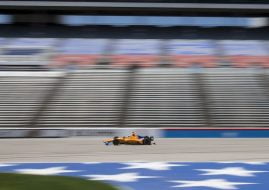McLaren F1 GTR - Le Mans Victory With Five Cars on the Top
There are many sports cars and racing cars that deserve a special place in history of motorsport. At the top of the list of the most significant names in the UK is undoubtedly the McLaren F1 GTR, which was a racing variant of the street version of the McLaren F1 sports car.
1995 24 Hours of Le Mans winner
Its production started in 1995, and over the next 10 years, the F1 GTR was used in various racing series, such as the BPR Global GT Series, FIA GT Championship, and Japanese GTC and British GT Championship. It is the most famous for its overall victory at the 1995 24 Hours of Le Mans.
McLaren Automotive and McLaren Special Operations at the 2015 Le Mans race celebrated the 20th anniversary of the famous Le Mans victory with the ultimate display at the French circuit. Five F1 GTRs, which finished the 1995 race, once again came to Le Mans and completed a parade lap. That was the first time all five cars had been on the track together since the chequered flag fell twenty years ago. The leader of the old F1 GTRs was the 1995 winner Yannick Dalmas in a new McLaren P1 GTR.

McLaren F1 GTR – 1995 Le Mans winner
All five McLaren-driven cars reached the finish
The 20th anniversary was a good reason to revisit all memories of the car which left a big mark in motorsport history. Back in 1995, five F1 GTRs crossed the finish line of the world’s most famous endurance race to complete one of the most dominant results the event had ever seen.
The McLaren F1 GTR, in its debut outing at the 24 Hours of Le Mans, claimed victory and also finished in third, fourth, fifth and 13th places against a field of specially-built prototypes and more established manufacturers. This result meant that McLaren was, and still is, the only manufacturer to have claimed the Triple Crown of Motorsport – victory at the 24 Hours of Le Mans, the Monaco Grand Prix and the Indianapolis 500. The 1995 Le Mans winning crew were Yannick Dalmas, Masanori Sekiya and JJ Lehto.

Gordon Murray, the creator of McLaren F1
The story began with road legal supercar
All began in 1992, when Gordon Murray created the McLaren F1, an ultimate road car with a BMW V12 engine. Two years later, the BPR Global GT Series was launched. Viewed as a possible replacement for the defunct World Sportscar Championship, BPR Series featured racing modifications of sports cars such as the Venturi 600LM, Ferrari F40 and Porsche 911 Turbo. Some team owners (Ray Bellm and Thomas Bscher) wanted McLaren in the series and Murray agreed to modify the F1 into a racing car.
No need for extensive modifications
Given the similarity with a race car, an extensive modification was not needed. Simple bodywork modification saw the addition of various cooling ducts, most noticeably a large one in the center of the nose and two placed in the location of the storage lockers on the side of the car. A large adjustable downforce wing was added to the back. The interior was stripped of all luxuries and given a full racing cage. Carbon brakes replaced the stock units. Features such as the central seating position, gull-wing doors, and even the stock gearbox were retained.

The power of BMW V12 engine was restricted to 600 hp
McLaren built nine cars for the maiden season
Because of the rules at the time, the BMW S70 V12 engine was required to use an air restrictor to limit horsepower to around 600 hp, actually making the racing car less powerful than the road car, but faster and more nimble due to a lowered overall weight.
Nine cars were built for the 1995 season, with #01R chassis being retained by the factory as a test mule. That car was raced only once, by Lanzante Motorsport (Kokusai Kaihatsu Racing) at the 1995 24 Hours of Le Mans, scoring the overall win. After that, the car was retired from racing immediately and kept by McLaren Cars.
BMW Motorsport had their own team of F1 GTRs
The British team GTC Racing received two F1 GTRs, with a third being used to replace a destroyed car. David Price Racing, BBA Competition, Mach One Racing and Giroix Racing Team received one chassis each while the final chassis #09R was sold to Hassanal Bolkiah, the Sultan of Brunei, for his car collection.
Following the success of the 1995 season, with the Le Mans victory and BPR championship titles, McLaren set forth to upgrade the car to keep it competitive, especially against the threat of newer sports cars such as Porsche 911 GT1. It was assisted by BMW Motorsport, who used F1 GTR for their own race team.

#51 McLaren F1 GTR finished third at 1995 Le Mans
At the 1986 Le Mans, Porsche was faster
Among the modifications were an extension of the front and rear bodywork, including a larger splitter attached to the front of the car. The bodywork was also modified to allow it to be removed more quickly for an easier repair. The car’s normal stock gearbox was modified to include a lighter magnesium housing and more robust mechanics. The total weight of the GTR was lowered by 38 kg.
Nine more new GTRs were built, while two older GTRs (#03R and #06R) were also modified to the 1996-spec. GTC Competition once again won the BPR championship title with F1 GTR. At 24 Hours of Le Mans, six of the seven McLarens finished the race, taking the 4th, 5th, 6th, 8th, 9th and 11th places. The overall winner was Joest Racing with Porsche prototype, while Porsche factory team with 911 GT1 took 2nd and 3rd places.

Longtail version of 1995 McLaren F1 GTR
The dawn of the longtailed McLaren F1 GTR in 1997
In 1997, the BPR Global GT Series reformed into the FIA GT Championship in 1997. The rules were changed, new competitors were a lot more daunting (Porsche 911 GT1, Mercedes CLK-GTR) and McLaren was forced to extensively modify the F1 GTR. Because of the modification to its bodywork, with a much longer nose and tail, the car was nicknamed F1 GTR Long Tail. Although it retained the same carbon fibre monocoque as the road car, the entire exterior of the car was specially built for racing, in order to maximize the aerodynamic downforce and allow the maximum amount of grip from the tyres.
The engine also underwent extensive modification, with a stroke reduction bringing the BMW S70 V12 down to 5990 ccm, in an attempt to prolong the life of the engines, while still maintaining the air restrictor-controlled cca. 600 hp. The stock gearbox was replaced with a new X-trac 6-speed sequential transmission.

1997 McLaren F1 GTR Longtail of Team Davidoff
McLaren took two Le Mans podiums with F1 GTR in 1997
A total of ten more GTRs were built, with none of the previous cars being upgraded to the 1997-spec. The new car was used by BMW-backed Schnitzer Motorsport, Team Davidoff and Parabolica Motorsport. Mercedes was the winner of the 1997 FIA GT Championship, while Schnitzer was second and Davidoff was third. BMW left the project at the end of 1997 in order to build its own Le Mans prototype – BMW V12 LM.
McLaren competed in the 1997 edition of the 24 Hours of Le Mans with six cars. Only two entries managed to finish, but they both performed well, taking 2nd and 3rd pace behind the winner Joest Racing in Porsche prototype. In 1998, only two McLaren F1 GTRs entered, both by privateer teams, with only one car finishing in fourth place.

McLaren F1 GTR competed in Japan until 2005
McLaren F1 GTR raced until 2005
For four seasons (1996-1999), McLaren F1 GTR was used by a few teams in the British GT Championship, with only one drivers championship title. The F1 GTR competed from 1996 to 2005 in the Japanese GTC Championship.
In the first year, Team Lark had won the championship title. In following years, a few Japanese teams had used the F1 GTR, but never as successfully as in its first year. The car was retired in 2005.

McLaren F1 GTR Art Car
Converted to street-legal machines
Following the end of competition for most F1 GTRs in 1998, the various chassis were put to different uses. Some cars, such as the Le Mans-winning chassis #01R, were put on public exhibition at motor shows or in museums.
Others were bought by private collectors, either for storage or for use by their owners in historic track day competitions. Some of the GTRs were not only bought by private owners, but also extensively modified by McLaren to make them street-legal machines and they are still driven today.
Photos: cars.mclaren.com.






